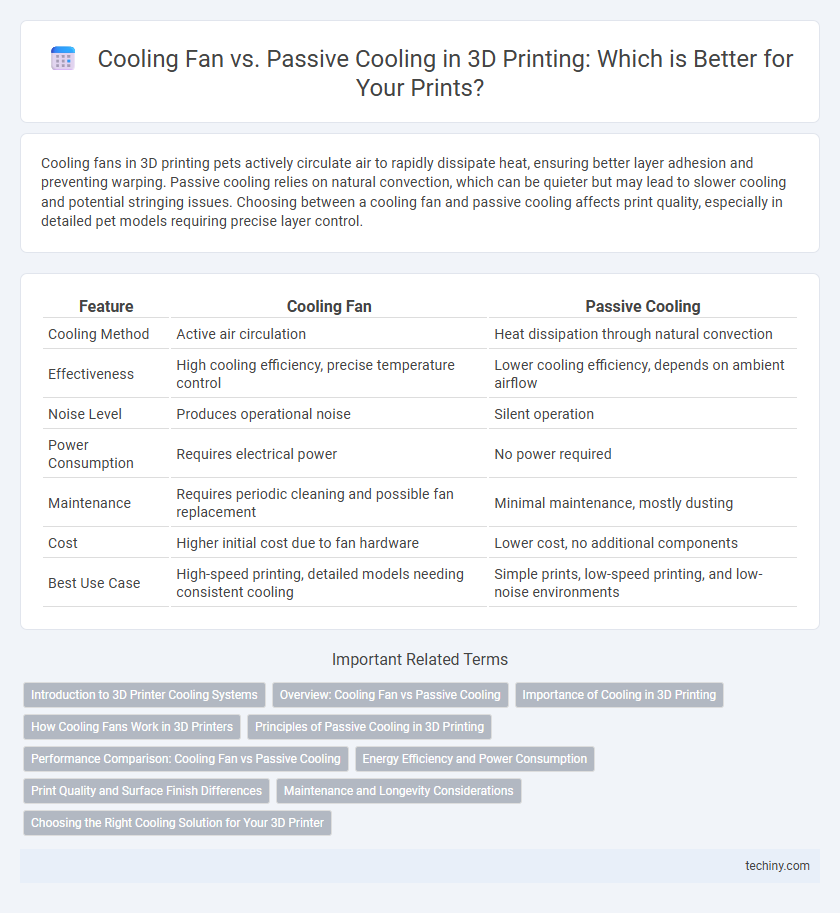Cooling fans in 3D printing pets actively circulate air to rapidly dissipate heat, ensuring better layer adhesion and preventing warping. Passive cooling relies on natural convection, which can be quieter but may lead to slower cooling and potential stringing issues. Choosing between a cooling fan and passive cooling affects print quality, especially in detailed pet models requiring precise layer control.
Table of Comparison
| Feature | Cooling Fan | Passive Cooling |
|---|---|---|
| Cooling Method | Active air circulation | Heat dissipation through natural convection |
| Effectiveness | High cooling efficiency, precise temperature control | Lower cooling efficiency, depends on ambient airflow |
| Noise Level | Produces operational noise | Silent operation |
| Power Consumption | Requires electrical power | No power required |
| Maintenance | Requires periodic cleaning and possible fan replacement | Minimal maintenance, mostly dusting |
| Cost | Higher initial cost due to fan hardware | Lower cost, no additional components |
| Best Use Case | High-speed printing, detailed models needing consistent cooling | Simple prints, low-speed printing, and low-noise environments |
Introduction to 3D Printer Cooling Systems
3D printer cooling systems are essential for maintaining optimal printing temperatures and ensuring high-quality prints. Cooling fans actively dissipate heat from the extruder and printed layers, enabling faster solidification and improved detail, while passive cooling relies on heat sinks and natural airflow without moving parts. Selecting the appropriate cooling method impacts print precision, material compatibility, and overall printer performance.
Overview: Cooling Fan vs Passive Cooling
Cooling fans in 3D printing actively regulate the temperature by circulating air over the printed layers, enabling faster solidification and reducing warping. Passive cooling relies on natural airflow and heat dissipation without mechanical assistance, which can result in slower cooling and potential issues with print quality, especially in complex geometries. Choosing between cooling fans and passive cooling depends on the material, print speed, and desired surface finish quality.
Importance of Cooling in 3D Printing
Effective cooling in 3D printing is crucial for improving print quality and preventing defects such as warping or stringing. Active cooling with a cooling fan rapidly solidifies the extruded filament, enabling finer detail and better layer adhesion, especially with PLA and other thermoplastics. Passive cooling relies on natural airflow and works for slower prints or materials less sensitive to heat, but may result in longer print times and lower surface finish quality.
How Cooling Fans Work in 3D Printers
Cooling fans in 3D printers actively regulate the temperature by directing airflow over the hotend and printed layers, preventing overheating and ensuring precise extrusion. These fans enhance print quality by rapidly solidifying the filament, which reduces warping and stringing defects common in thermoplastic materials like PLA and ABS. Compared to passive cooling, active fan cooling provides consistent thermal management critical for complex geometries and high-speed printing processes.
Principles of Passive Cooling in 3D Printing
Passive cooling in 3D printing relies on natural heat dissipation through conduction, convection, and radiation without using mechanical components like fans. Heat generated by the hotend or heated bed is transferred to heat sinks or spread across metal surfaces to lower temperatures effectively. This method reduces noise and energy consumption while maintaining stable printing conditions, particularly in low-speed or compact 3D printers.
Performance Comparison: Cooling Fan vs Passive Cooling
Cooling fans in 3D printing provide active airflow that significantly enhances heat dissipation, leading to improved layer adhesion and reduced warping compared to passive cooling methods. Passive cooling relies on natural convection and ambient temperature, which may result in slower cooling rates and potential print defects in intricate geometries. Performance comparison data indicates that active cooling fans can reduce print times by up to 20% and increase print quality consistency, especially in materials like PLA and ABS.
Energy Efficiency and Power Consumption
Cooling fans in 3D printers actively regulate temperature with higher energy consumption, typically drawing around 2-5 watts during operation. Passive cooling relies on natural heat dissipation without electrical power, making it more energy-efficient but less effective for rapid temperature changes. Choosing between active and passive cooling directly impacts overall power consumption and printer performance in complex or high-speed printing tasks.
Print Quality and Surface Finish Differences
Active cooling fans improve print quality by rapidly solidifying the filament, reducing warping and stringing, which results in finer surface finish and sharper details. Passive cooling, relying on ambient airflow, often causes slower cooling rates that may lead to layer deformation and less precise surface textures. Optimizing cooling strategies with fans is crucial for complex geometries and bridging, enhancing overall print accuracy and aesthetic appeal.
Maintenance and Longevity Considerations
Cooling fans in 3D printers require regular maintenance, including cleaning dust and checking the motor to ensure optimal airflow and prevent overheating. Passive cooling systems have minimal maintenance needs due to the absence of moving parts, reducing the risk of mechanical failure and prolonging component lifespan. Choosing between active and passive cooling impacts the printer's longevity based on maintenance capabilities and operational environment.
Choosing the Right Cooling Solution for Your 3D Printer
Choosing the right cooling solution for your 3D printer depends on print speed, material, and model complexity. Active cooling with a fan provides faster heat dissipation, reducing stringing and improving layer adhesion for detailed prints. Passive cooling relies on heat sinks and airflow design, offering quieter operation and lower maintenance but may struggle with high-temperature or intricate prints.
Cooling Fan vs Passive Cooling Infographic

 techiny.com
techiny.com